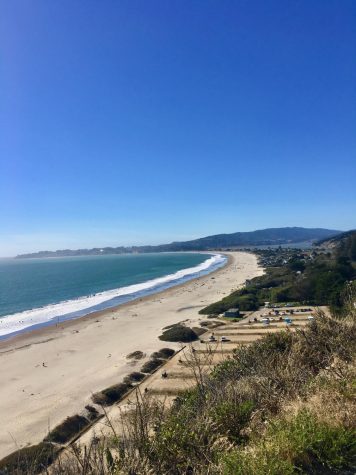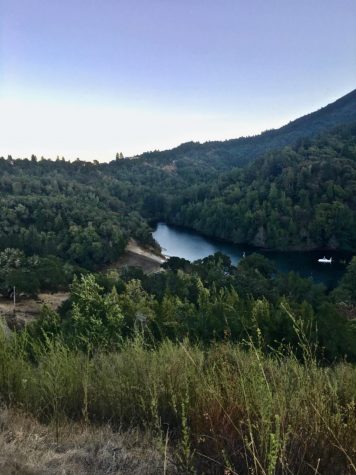The wonders of Mt Tam: How local organizations are preserving Marin’s prized beauty
October 30, 2018
Watching the sun set over the Bay Area from Mount Tamalpais’ Bolinas Ridge is an experience often reserved for Marin residents who know the mountain’s coveted spots. Just a few miles from the high-stress, crowded city of San Francisco, Mount Tamalpais (Tam) is a place of solace and quiet. Looming ominously over Mill Valley, Mount Tam is, in many ways, the heart and soul of Marin County. In recent years, Mount Tam has experienced threats to its diverse ecosystems as a result of climate change, forest fires and man-made construction. In an effort to restore the health of Marin’s cherished terrain, the Tamalpais Land Collaborative and many other community organizations have come together to maintain the mountain’s condition.
According to Gary Yost’s documentary, “The Invisible Peak,” for nearly 5,000 years, long before the colonization of America, Mount Tamalpais sheltered the indigenous peoples of the Pacific Coast. Not only was the mountain a source of food and water, but it had a spiritual importance that unequivocally tied the natives to its ecosystems. Respect for the mountain and its natural

Mount Tam not only overlooks Marin’s several towns, it also has a face on the water where hikers can gain a beautiful view of Stinson Beach like this one.
resources continued with the development of Marin County where hiking and the outdoors became a quintessential part of the area. Even today, Fairfax and Mill Valley are centered around the mountain, with many local businesses thriving off of the 2.7 million visitors that come to Tamalpais each year, according to the Marin Municipal Water District Census.
As displayed in the documentary, peaceful coexistence with the mountain did not last long. With the U.S. involvement in the Cold War, the government soon made Mount Tam a lookout point for nuclear missiles and incoming planes. As a result, half a million cubic yards of the mountain’s west peak were destroyed to make room for new military bases and a large radar. These military operations have had long-lasting and devastating repercussions on Tam’s surrounding wildlife. After the end of the Cold War, the concrete buildings were abandoned and West Peak was left in desolation.
In the fall of 1989, the Dalai Lama visited the peak of Mount Tam and reignited the spirits of Marin residents who felt helpless in restoring their favorite location. With a newfound energy, the Tam Conservation Club began projects to rehabilitate the mountain. Within a few decades, the protection of Mount Tamalpais would become the primary focus of over a dozen local organizations.
One Tam, an initiative of the Tamalpais Lands Collaborative, was founded in 2014 and pools the resources of these local organizations to more effectively tackle some of Tam’s most pressing issues.
Lisette Arellano, One Tam’s Community Science Manager, expressed that One Tam has allowed her to give back in a meaningful way.
“I am excited to be contributing and connecting people to a land that gave so much to me when I was younger,” Arellano said, adding that community projects like these help build unity and promote the mountain’s wildlife.
Data is a vital part of the process when it comes to rehabilitating the mountain according to Monica Stafford, the Community Ambassador Program Director for One Tam. Stafford said the lack of research prior to One Tam’s establishment had contributed to a less effective management of Tam.
“One Tam was created with the intention to manage the mountain more holistically and intelligently,” Stafford said. “Not enough information was available on things like pollinators or Coho Salmon populations which are essential to the mountain’s health.”
As one of its ongoing projects, One Tam has initiated a study on the pollinators of Mount Tam by working with Marin residents to create a database of bees. With over 500 bee species present on the mountain, according to Dr. Arellano, the organization has been able to determine how to tackle the rehabilitation of plants in some of the most endangered ecosystems.
In addition to smaller, community-based projects, One Tam has published extensive research-based reports on the mountain’s health to aid scientists in efforts of rehabilitation. According to the collaborative’s website, OneTam.org, One Tam now has the

The beautiful view of a Mt. Tam slope from Natalie Coffin Greene Park in Ross, CA.
continent’s largest array of wildlife cameras that produce more than a million images of Tam’s mammals, contributing to an even more accurate system for researching how to help the mountain.
With access to research about Tam’s health, thanks to years of community collaboration, state officials and local organizations are now actively working to help preserve some of the mountain’s most beautiful features.
One of the most daunting and immediate threats to Tamalpais is the possibility of forest fires, according to Stafford. Like many forests in California, Tam’s woodlands are adapted for the possibility of fires. However, man-controlled fire suppression has created an even more threatening situation for the mountain.
“Right now, the decades of fire suppression threaten some of Tam’s ecosystems,” Stafford said, “When a forest hasn’t experienced a fire in so long, a new fire is more dangerous as it can burn faster and is almost 10 times stronger.”
Stafford noted that the mountain’s ecosystems, which haven’t experienced a large forest fire in nearly 80 years, may not be able to regrow if a new, stronger fire erupts.
According to One Tam’s 2016 report on Mount Tam’s health, it may be more prone to forest fires because of climate change trends that predict hotter, drier environments. This poses the question: how does one protect Marin’s property if forest fires are needed to support its wildlife? It’s a delicate balance that local organizations have wrestled with for years.
Problems like these have arisen over the past few decades, alarming scientists and residents alike. One Tam has tackled these issues through research-based initiatives that incorporate the community into its efforts. The reliance on Mount Tam by Marin’s culture and economy has prompted One Tam’s goals of rehabilitating the mountain to its original health and restoring the heart of Marin.
Sucha Sudarsanam, a resident in Greenbrae since 1999, feels that the mountain is an integral part of his life in Marin.
“I’ve lived here for 20 years and mountain bike on Tam almost every day,” he said. “Without this mountain, I probably wouldn’t have stayed here for as long as I have.”
Sudarsanam’s connection to Mount Tamalpais is not unique; many Marin residents live in the area due to the proximity of the mountain. Local businesses such as Caesar’s Bike Shop in San Anselmo rely on Tamalpais bikers for their business. Without the mountain, communities’ local shops wouldn’t thrive like they do today.
Bringing in hundreds of millions of dollars a year to Marin County, according to Stafford, Tamalpais is an integral part of the local economy. The money that is brought into Marin is circulated through school districts and goes towards maintaining the pristine parks found in the county. The homes in Greenbrae and the Kentfield Woodlands, which are known for their views of the mountain, draw buyers every year specifically for their views of nature.
Impactful as it already is, One Tam’s efforts will truly shine in the near future as more scientists evaluate the mountain’s ever-changing landscapes and evolution. In the meantime, high school students can get involved by volunteering for One Tam or through an eight-week paid internship during the summer. With such an influential ecosystem so close to Marin, community involvement is key to uphold the sense of belonging that the mountain has fostered for so long.







